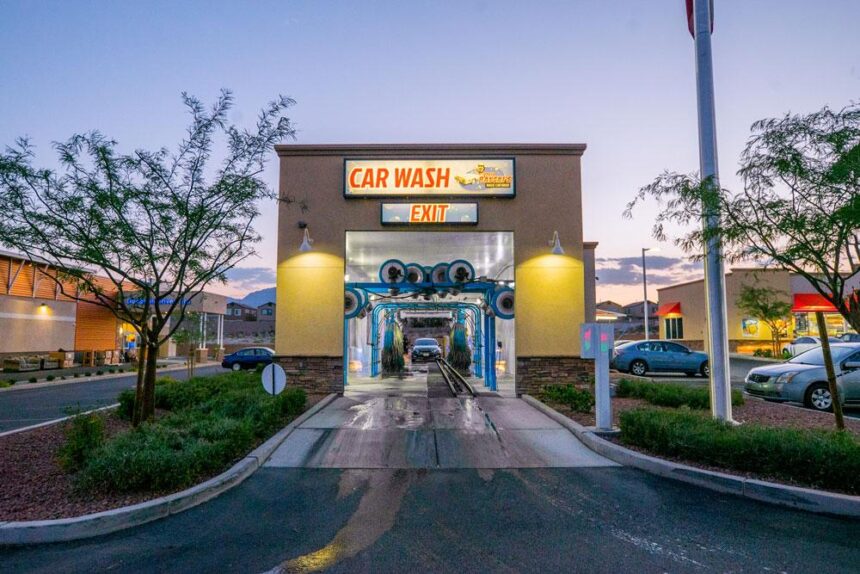How Rain Transforms the Car Wash Experience in Las Vegas
Surge in Demand and Muddy Challenges Post-Rainfall
In the typically sun-soaked city of Las Vegas, an uncommon rainstorm triggers a notable shift in the daily rhythm of car wash employees. Contrary to the assumption that rain might slow business, these sudden showers actually lead to a sharp increase in customers seeking to cleanse their vehicles of accumulated grime. Cars coated with thick layers of mud, often dragged in from nearby construction zones and dusty, unpaved streets, flood the car wash bays. This influx frequently overwhelms staff and machinery, causing longer wait times and necessitating quicker yet meticulous service to maintain customer satisfaction.
Key operational challenges during these busy periods include:
- Efficiently managing extended queues without compromising service quality.
- Mitigating abrasive damage to equipment caused by gritty mud.
- Optimizing water pressure and consumption to handle heavier soil loads.
- Preventing contamination between vehicles through runoff control.
| Mud Severity | Typical Cleaning Duration | Impact on Equipment |
|---|---|---|
| Light (Dust and Surface Dirt) | Approximately 10 minutes | Minimal |
| Moderate (Wet Mud) | Around 15 minutes | Moderate |
| Severe (Heavy Mud and Debris) | Up to 25 minutes | High |
Proactive Equipment Care to Combat Rain-Induced Wear
Ensuring the smooth operation of car wash machinery during and after rainfall is essential to avoid service interruptions. Moisture and mud accumulation can cause mechanical failures if not addressed promptly. To counteract these risks, staff conduct thorough daily inspections, focusing on cleaning, lubricating moving parts, and safeguarding electrical components from moisture-related damage. This preventative maintenance approach not only reduces downtime but also prolongs the lifespan of costly equipment.
Maintenance routines include:
- Draining water from vulnerable machine sections to prevent corrosion.
- Replacing filters clogged by dirt and debris.
- Testing safety sensors to ensure reliable operation.
- Inspecting brushes and nozzles for blockages or wear.
- Recording maintenance findings to identify recurring issues.
| Maintenance Task | Frequency | Benefit |
|---|---|---|
| Water Drainage | Daily | Prevents rust and corrosion |
| Sensor Function Tests | After Rainfall | Ensures operational safety |
| Brush and Nozzle Checks | Weekly | Maintains cleaning effectiveness |
Innovative Customer Service Adjustments for Rainy Days
When unexpected rain dampens the Las Vegas streets, car wash teams swiftly adapt to the surge in customers eager to refresh their vehicles. Emphasizing speed without sacrificing quality, many locations implement flexible scheduling and accelerated wash options. Clear communication becomes vital, with staff actively informing customers about wait times and tailoring services to meet weather-related demands, thereby enhancing overall satisfaction.
Some effective strategies include:
- Dedicated express lanes for customers who reserve services via mobile apps.
- Issuing rain check vouchers that allow discounted washes on future dry days.
- Upgrading drying stations to better eliminate water spots after rain.
| Strategy | Customer Benefit | Implementation Timeline |
|---|---|---|
| Mobile Express Booking | Shortens wait times | Immediate |
| Rain Check Vouchers | Encourages repeat visits | Within 24 hours |
| Enhanced Drying Facilities | Improves vehicle finish | One week |
Ensuring Staff Safety During Rain-Impacted Shifts
Post-rain shifts demand heightened safety awareness to protect employees from hazards associated with wet environments. Wearing slip-resistant shoes is crucial to prevent falls on slick surfaces, while waterproof clothing and gloves help maintain grip and comfort. Regular monitoring of electrical systems is mandatory to avoid accidents caused by moisture exposure. Supervisors conduct briefings before shifts to reinforce safety protocols and encourage open communication among team members.
Key safety measures include:
- Frequent floor inspections to identify and address water pooling.
- Placement of absorbent mats in high-traffic zones to reduce slip risks.
- Careful handling of cleaning chemicals, as wet conditions can increase exposure hazards.
- Regulating vehicle entry to minimize congestion and potential collisions.
| Safety Measure | Objective | Effectiveness |
|---|---|---|
| Slip-Resistant Footwear | Reduce fall incidents | 40% decrease in injuries |
| Absorbent Mats | Limit wet floor hazards | Enhanced staff mobility |
| Electrical Equipment Checks | Prevent electrocution risks | No reported electrical accidents |
Final Thoughts: Resilience in the Face of Rain
Working at a Las Vegas car wash following rare rain events presents a distinctive set of obstacles and opportunities. While the city’s famously dry streets often self-clean, the sudden appearance of mud and debris demands extra effort and vigilance from employees. This habitat highlights the adaptability and dedication of workers who ensure smooth operations irrespective of weather conditions.As Las Vegas continues to experience occasional rainfall, the car wash sector exemplifies how local industries adjust and thrive amid nature’s unpredictability.
